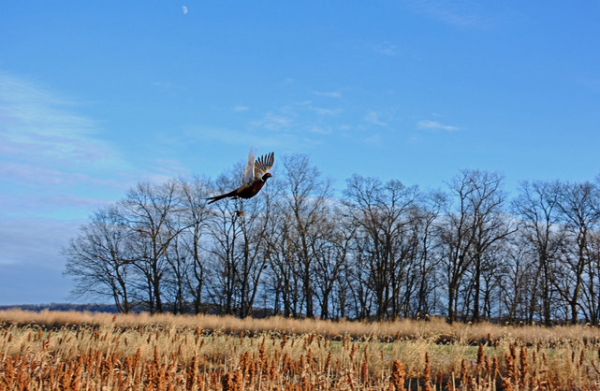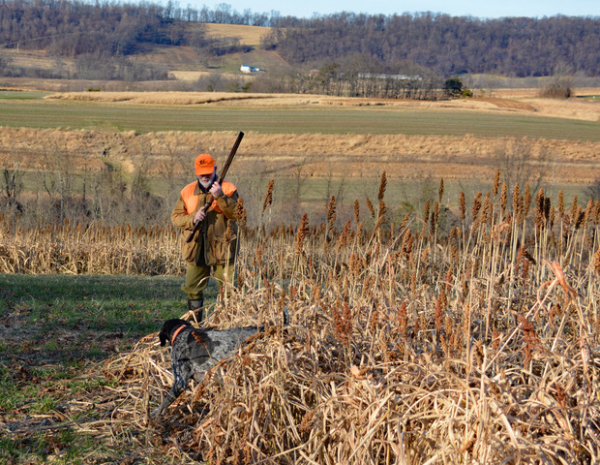
Up to 100,000 Birds Ordered Destroyed Following Disease Outbreak
Gamebirds such as pheasant, partridge and quail raised for shooting preserves and hunting field trials are an indispensable part of the shooting sports and dog training scene, especially in the eastern United States where wild bird numbers have been diminishing for generations. One of the biggest, recent fears for gamebird suppliers and shooting preserves is the rise of High Path Avian Influenza (HPAI), a disease devastating many commercial poultry farms and impacting wildfowl numbers across North America.
Those worst fears were realized just before Christmas at Martz’s Gap View Hunting Preserve, a 1,300-acre facility in Dalmatia, Pennsylvania. The preserve is one of the largest operations of its kind in the Mid-Atlantic, with up to 5,000 hunter visits annually. Birds such as pheasant, chukar, Hungarian and French red-legged partridges are also sold to shooting preserve and hunting club customers across multiple states. Up to 100,000 farm-raised gamebirds, including 85,00 pheasants, were destroyed in the days after the flu was discovered.
Mike Martz, the third-generation owner/manager of the preserve, said the disease was confirmed Dec. 22 by a Pennsylvania laboratory. The USDA’s National Veterinary Services Lab confirmed the results.
Infected birds shed bird flu virus through their saliva, mucous and feces, according to the U.S. Centers for Disease Control.
“We don’t know how we got it,” Martz said. “We follow strict bio-security procedures. We disinfect vehicle tires. Employees wear booties while they’re in the pens. You always worry. You can’t control what might fly over, unfortunately. We’ve had a lot of geese fly over and raptors visit the pens.”
Smaller, infected birds that get in the pens looking for a meal can also spreads the virus.
The issue surfaced when a Martz employee observed higher mortality than usual in one pen of pheasants. Some large pens can hold up to 3,000 pheasants while smaller pens might have as few as 400, Martz said.
“I went out to observe and didn’t see any of the outward symptoms of avian flu. Except for the unexplained losses, the birds appeared healthy,” Matz said.
While the disease appeared confined to a single pen, protocols dictate that the entire facility is “depopulated.” Martz worked with the USDA and the Pennsylvania Department of Agriculture, with destruction of the birds occurring daylight to dusk. A local fire department assisted with water needs for applying the foaming method of depopulation, a government-approved method.
Eradication of this type has been conducted before in chicken houses, where the congregated birds don’t fly. Sources shared that this could be the first time the method has been attempted in huge outdoor rearing pens with flighted birds.
Jay Losiewicz, deputy communications director of the Pennsylvania Department of Agriculture, said infection at the Martz facility represents the first-time avian flu has been found at a Pennsylvania gamebird operation. Pennsylvania has some of the largest such operations on the East Coast. He said a unified incident command team was established by his agency and the USDA Animal and Plant Health Inspection Service.
Once depopulation is completed, Losiewicz said, infected and exposed animals must be properly disposed of, as required by the Pennsylvania Dead Animal Disposal Law. Preferred disposal options for flocks infected with bird flu include composting, burial, or incineration. The Martz birds are being composted.
“It feels like you’ve been punched in the stomach,” Martz said. “You can feel sorry for yourself or realize you have neighbors and rally the troops to do all you can to keep this from spreading.”
“This infection was likely spread by migrating birds and it is possible that some other sites in the area may have been infected by the same or other migrating flocks,” Losiewicz said, adding his agency is surveillance testing all premises within the 10-kilometer control area and 10-20-kilometer surveillance zone to ensure early detection of new cases. One of the eastern United States’ largest gamebird breeders, raising some half-million birds annually, is Mahantongo Game Farms, just a few miles from the Martz’s Gap facility.
In terms of the value of the destroyed birds, Martz said a ballpark estimate is $1.9 million. This includes the “breeder” birds, considered the most valuable since they lay up to 70 eggs annually. “There is federal indemnity,” Martz said. “If the federal government orders you to destroy your flock, they pay fair market value for the birds.”
Losiewicz said Pennsylvania also has the HPAI Recovery Reimbursement Grant Program, which reimburses farms, integrators, and allied industries, directly impacted by HPAI and suffering demonstrable financial losses. “This first-in-the-nation reimbursement program is a special appropriation that helps ensure continuity of business for premises impacted by the disease or within control zones up to $1 million per event based on documented losses,” he said.
Martz, seemingly looking for a positive aspect, said the disease hit after they had already fulfilled 62 percent of seasonal customer orders. The facility can begin restocking after it is determined it is free of the virus. Since pheasants are raised on the ground in outdoor pens and the facility can’t be cleaned and disinfected like more self-contained facilities like chicken houses, an extended quarantine can be put in place, according to information provided by Losiewicz. The governmental case manager selects dates for sample collection from several places in the farm environment, and those samples will be assessed at the state laboratory. “Restocking Agreements” extend the partnership between the farmer and as the farm returns to full production, with the new flock tested three times after placement.
“My main worry is for our customers, those who will see a direct loss of income, without the indemnity we receive,” Martz said. “I also worry about our neighboring farms.” Martz said customers who received birds from his operation have been notified, with the expectation that appropriate protocols relative to assessing any transferred birds will be followed.
Ripple Effect Potential
The ripple effects from infection at gamebird suppliers can extend across multiple states and impact preserve shooting and field trials for months. Already increasingly expensive in recent years due to the rising feed and transportation prices, getting your dog some work in a shooting preserve or a title in a field trial may further dent wallets.

People finding sick or dead wild birds should report them to their state fish and wildlife agency. The disease appears somewhat widespread this season. Officials in South Carolina also reported a large multi-county die-off of infected wood ducks just before Christmas.
According to the CDC, “Human infections with bird flu viruses can happen when virus gets into a person’s eyes, nose or mouth, or is inhaled. This can happen when virus is in the air (in droplets or possibly dust) and a person breathes it in, or possibly when a person touches something that has virus on it then touches their mouth, eyes or nose. Human infections with bird flu viruses have occurred most often after unprotected contact with infected birds or surfaces contaminated with bird flu viruses.”
A study by Ducks Unlimited showed very little (about 2 percent) infection rate among dogs that hunted waterfowl. Still, as a matter of caution, DU recommends that dogs not be allowed to retrieve or contact birds that appear sick or were found dead. Hunters also should not feed dogs raw meat from harvested birds nor allow them to contact discarded carcasses or entrails.
— Ken Perrotte
What Happens When Avian Flu is Detected
Step 1 - Quarantine:
A quarantine is put in place to help stop the spread of disease off the farm. A quarantine means that no poultry or other birds may come onto or be removed from the farm. This includes products like eggs and manure. This helps protect neighbors and the industry within Pennsylvania. The quarantine will remain in place until it can be determined safe to move animals and products again without spreading disease.
Step 2 - Testing:
Swab samples are collected from the flock and tested at the laboratory. Since bird flu was detected at this premise, a 10-kiloeter control area and a 10 to 20-kilometer surveillance zone were placed.
Step 3 - Depopulation:
All birds remaining on the infected premises will be humanely depopulated.
Step 4 - Disposal:
Infected and exposed animals and products must be properly disposed of. Preferred disposal options for flocks infected with bird flu include composting, burial, or incineration. Composting on the farm property is the preferred method, and a composting expert is available to manage this process.
Step 5 - Cleaning and Disinfection/Virus Elimination:
The final step is making sure the farm is free of virus before restocking with birds, so the new flock remains healthy. If a premise can’t be entirely cleaned and disinfected properly, it may remain under quarantine for an extended period as determined by an epidemiologic evaluation. This includes premises where birds are housed outdoors on bare ground, where cleaning and disinfection is impossible.
Step 6 – Restocking:
After the area has been determined to be free of the virus, restocking can begin. Follow-up testing on new flocks will occur three times to ensure the flock is healthy.
Step 7 – Recovery:
Affected businesses can apply for reimbursement costs for the loss of the flock and business through both the United States and Pennsylvania Departments of Agriculture.
(Provided by Pennsylvania Department of Agriculture)